Patron Saint of Cryptozoologists?
Posted by: Loren Coleman on June 9th, 2012
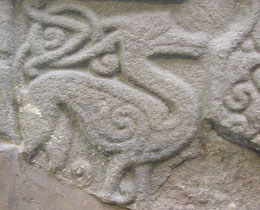
Ancient art.
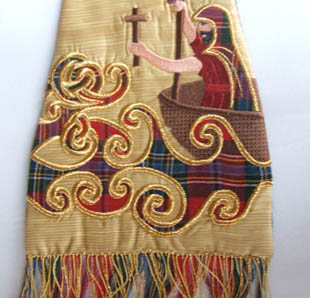
Ecclesiastical embroidery of St. Columba encounter by Ruth Black.
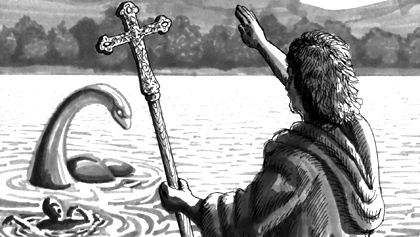
St. Columba encounter by William Rebsamen.
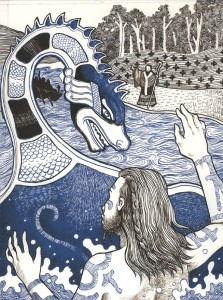
St. Columba encounter by Lauras Muse.
T. Peter Park suggests the following:
Today, June 9, is a Church feast day that might be of interest to cryptozoologists! It is the Feast of St. Columba (7 December 521 – 9 June 597 AD), Old Irish Colum Cille (“Dove of the Church”), an Irish Gaelic missionary monk who propagated Christianity among the Picts (ancient Scots) in the early Middle Ages. Columba founded three monasteries, including Iona Abbey on the small Scottish offshore island of Iona. That monastery, one of Western Europe’s oldest and most important religious centers, was left in ruins after the Reformation, but is the home today of an ecumenical religious community. According to some modern Forteans, Columba was history’s first recorded witness of the Loch Ness Monster. Cryptozoologists cite the Life of St. Columba, written in the 7th century, a century after the incident in question, by his successor St. Adomnán of Iona (627–704), Abbot of Iona (679–704), describing Columba driving off a man-eating monster in the River Ness near the Loch by making the sign of the Cross and ordering the beast to leave a swimmer alone, go no further, and leave at once! The monster halted immediately and fled in terror, and both Columba’s men and the pagan Picts praised God for the miracle! Skeptics, however, note that stories of water-beasts were quite common in mediaeval saints’ Lives, with Adomnán’s tale probably just a recycling of a common motif attached to a local landmark—at best, even if the story had any factual basis, it might have just described a walrus or similar creature that had swum up the river!
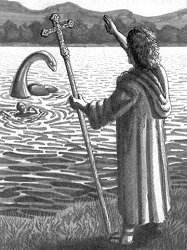
St. Columba encounter by William Rebsamen.
About Loren Coleman
Loren Coleman is one of the world’s leading cryptozoologists, some say “the” leading living cryptozoologist. Certainly, he is acknowledged as the current living American researcher and writer who has most popularized cryptozoology in the late 20th and early 21st centuries.
Starting his fieldwork and investigations in 1960, after traveling and trekking extensively in pursuit of cryptozoological mysteries, Coleman began writing to share his experiences in 1969. An honorary member of Ivan T. Sanderson’s Society for the Investigation of the Unexplained in the 1970s, Coleman has been bestowed with similar honorary memberships of the North Idaho College Cryptozoology Club in 1983, and in subsequent years, that of the British Columbia Scientific Cryptozoology Club, CryptoSafari International, and other international organizations. He was also a Life Member and Benefactor of the International Society of Cryptozoology (now-defunct).
Loren Coleman’s daily blog, as a member of the Cryptomundo Team, served as an ongoing avenue of communication for the ever-growing body of cryptozoo news from 2005 through 2013. He returned as an infrequent contributor beginning Halloween week of 2015.
Coleman is the founder in 2003, and current director of the International Cryptozoology Museum in Portland, Maine.










Accounts like this are important, and awesome to use in research!
Where is that ancient art from?
The carved stone art is one of the Pictish Beasts, apparently made by the Picts, generally found in southern Scotland and northern England.
Clearly the account is exagerrated, the research is to find the underlying kernel of truth. The fact that there is at least one other account of Columba meeting this beast in Loch Ness suggests it was something moe indigenous.
Really, the story about St. Columba has to be understood in the same way as the story of St. Patrick driving the snakes out of Ireland; both are really stories about Christianity driving out demons, not stories about any kind of zoology.
For a story with some similarities, see the account of St. Anthony’s journey to see St. Paul the Hermit. St. Anthony meets both a centaur and a satyr, which the Greek version of the story explicitly states are demons.
If anyone is really interested in a patron saint for cryptozoology, it appears that St. Albert the Great is considered the patron saint of the sciences, but Adam would make an appropriate patron saint for zoology in particular, because he named the animals. (Likewise, Solomon later named the plants, making him a good candidate for patron saint of botany.)
The stone art/Pictish beast is very interesting. Could it be a four legged, wingless dragon, a stylized elk (or perhaps a stylized Giant Irish Elk…?) or a proto-Kelpie? The artwork makes me think of a similar piece of Norse art (I’ll see if i can find it and post it here).
BTW: here it is, the Norse Gripping Beast.
A provocative carving; certainly, depictions of similar creatures in the ancient world are not rare.
My first impression was that it resembled the Parasaurolophus. However, it became clear that the subject does not have a crest protruding from the back of its head. They instead look like fleshly appendages of some sort [or hair?].
I don’t agree that St.Columba’s Loch Ness encounter is to be treated as something demonic for the text doesn’t suggest it. It is merely described as a “water beast” and I think we are meant to understand that it was an animal and no more. The miracle for that encounter was to demonstrate the control St.Columba’s God had over nature and not anything to do with demons.
Moreover, the same biography by Adamnan mentions Columba encountering a whale off the Scottish coast. Are we meant to regard that as demonic too? In the same light, we should regard the water beast seen in the river as an animal too.
Very interesting account!
I’m part Scottish (and also Catholic btw).
Also to Bob K:
I have the same name as you almost as my name is Bob and my last name starts with a K as well. 😉
Glad to know ya, forthcoming!
silverity: I’d agree.
One of the most subtle, pervasive, and insidious forms of racism – or to put it more mildly, as that really isn’t the case here, blinkered thinking – is to presume that anything another culture believes for which you don’t have proof is a “legend” or a “myth” or a “quaint belief.”
The example I would use is the sasquatch, for which native cultures don’t use any terms or references in describing it that they don’t use as well for the animals we know about. To this day Native Americans and First Nations people – 21st-century people in most every other sense – insist it’s real.
It’s my personal opinion that zoology would make a whole lot more headway as a science, a whole lot more quickly, by focusing less on the DNA sequencing of mouse lemurs and more on investigating the possible basis for species that may be out there but we haven’t confirmed yet. Just killing the kneejerk scoff would be one of the biggest sea changes in the history of science.
Look where physics, chemistry, astronomy and paleobiology (for the most part) are going. They are all – despite some obvious flaws – very-low-scoff-quotient sciences.